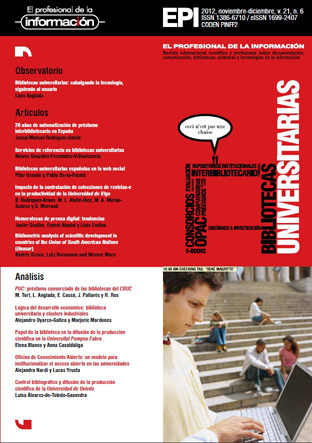Impact of subscription to electronic journals collections on academic productivity at the University of Vigo
DOI:
https://doi.org/10.3145/epi.2012.nov.05Keywords:
Academic libraries, Electronic contents, Electronic information, Electronic journals, Impact, Information consumption, Information use, Scientific productivity, ScienceDirect, Scopus, SpringerLink, Web of Science, Wiley, University of Vigo.Abstract
The aim of the study is to test a methodology to investigate the correlation between the models of electronic information usage and the scientific communication preferences reflected in two databases: Web of Science (WoS) from Thomson Reuters, and Scopus from Elsevier. The study is focused on the University of Vigo. Downloads of the articles distributed by ScienceDirect, SpringerLink and Wiley were analyzed at the University of Vigo (Spain) in the period 2006 to 2011. There is an ascending curve for the consumption of electronic scientific content and a preference for titles distributed by ScienceDirect. The study confirms that experimental and health sciences researchers are the most devoted users, to judge by the number of articles downloaded. Increase in scientific production was also analyzed by discipline. There was a direct correlation between the most productive disciplines and those in which higher numbers of journal articles were downloaded. Nevertheless, no direct correlation was observed between the titles preferred for scientific communication and the titles receiving greater use in the multidisciplinary platforms studied.
Downloads
Downloads
Published
How to Cite
Issue
Section
License
Dissemination conditions of the articles once they are published
Authors can freely disseminate their articles on websites, social networks and repositories
However, the following conditions must be respected:
- Only the editorial version should be made public. Please do not publish preprints, postprints or proofs.
- Along with this copy, a specific mention of the publication in which the text has appeared must be included, also adding a clickable link to the URL: http://www.profesionaldelainformacion.com
- Only the final editorial version should be made public. Please do not publish preprints, postprints or proofs.
- Along with that copy, a specific mention of the publication in which the text has appeared must be included, also adding a clickable link to the URL: http://revista.profesionaldelainformacion.com
Profesional de la información journal offers the articles in open access with a Creative Commons BY license.




